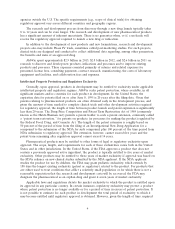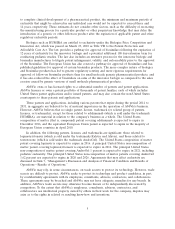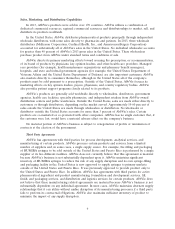AbbVie 2013 Annual Report Download - page 18
Download and view the complete annual report
Please find page 18 of the 2013 AbbVie annual report below. You can navigate through the pages in the report by either clicking on the pages listed below, or by using the keyword search tool below to find specific information within the annual report.AbbVie normally responds to challenges by vigorously defending its patents, including by filing
patent infringement lawsuits. Patent litigation and other challenges to AbbVie’s patents are costly and
unpredictable and may deprive AbbVie of market exclusivity for a patented product. To the extent
AbbVie’s intellectual property is successfully challenged or circumvented or to the extent such
intellectual property does not allow AbbVie to compete effectively, AbbVie’s business will suffer. To the
extent that countries do not enforce AbbVie’s intellectual property rights or require compulsory
licensing of AbbVie’s intellectual property, AbbVie’s future revenues and operating income will be
reduced.
A third party’s intellectual property may prevent AbbVie from selling its products or have a material adverse
effect on AbbVie’s future profitability and financial condition.
Third parties may claim that an AbbVie product infringes upon their intellectual property.
Resolving an intellectual property infringement claim can be costly and time consuming and may
require AbbVie to enter into license agreements. AbbVie cannot guarantee that it would be able to
obtain license agreements on commercially reasonable terms. A successful claim of patent or other
intellectual property infringement could subject AbbVie to significant damages or an injunction
preventing the manufacture, sale, or use of the affected AbbVie product or products. Any of these
events could have a material adverse effect on AbbVie’s profitability and financial condition.
Any significant event that adversely affects HUMIRA revenues could have a material and negative impact on
AbbVie’s results of operations and cash flows.
HUMIRA generates approximately 57 percent of AbbVie’s sales. Any significant event that
adversely affects HUMIRA’s revenues could have a material adverse impact on AbbVie’s operations
and cash flows. These events could include loss of patent protection for HUMIRA, the approval of
biosimilars of HUMIRA, the discovery of previously unknown side effects or impaired efficacy,
increased competition from the introduction of new, more effective or less expensive treatments, and
discontinuation or removal from the market of HUMIRA for any reason.
AbbVie’s research and development efforts may not succeed in developing and marketing commercially
successful products and technologies, which may cause its revenue and profitability to decline.
To remain competitive, AbbVie must continue to launch new products and new indications and/or
brand extensions for existing products, and such launches must generate revenue sufficient both to
cover its substantial research and development costs and to replace sales of profitable products that are
lost to or displaced by competing products or therapies. Failure to do so would have a material adverse
effect on AbbVie’s revenue and profitability. Accordingly, AbbVie commits substantial effort, funds,
and other resources to research and development and must make ongoing substantial expenditures
without any assurance that its efforts will be commercially successful. For example, in 2012 AbbVie
discontinued the development of ABT-263, which was in Phase II development for the treatment of
hematologic malignancies. A high rate of failure in the biopharmaceutical industry is inherent in the
research and development of new products, and failure can occur at any point in the research and
development process, including after significant funds have been invested. Products that appear
promising in development may fail to reach the market for numerous reasons, including failure to
demonstrate effectiveness, safety concerns, superior safety or efficacy of competing therapies, failure to
achieve positive clinical or pre-clinical outcomes beyond the current standard of care, inability to obtain
necessary regulatory approvals or delays in the approval of new products and new indications, limited
scope of approved uses, excessive costs to manufacture, the failure to obtain or maintain intellectual
property rights, or infringement of the intellectual property rights of others.
Decisions about research studies made early in the development process of a pharmaceutical
product candidate can affect the marketing strategy once such candidate receives approval. More
14
























